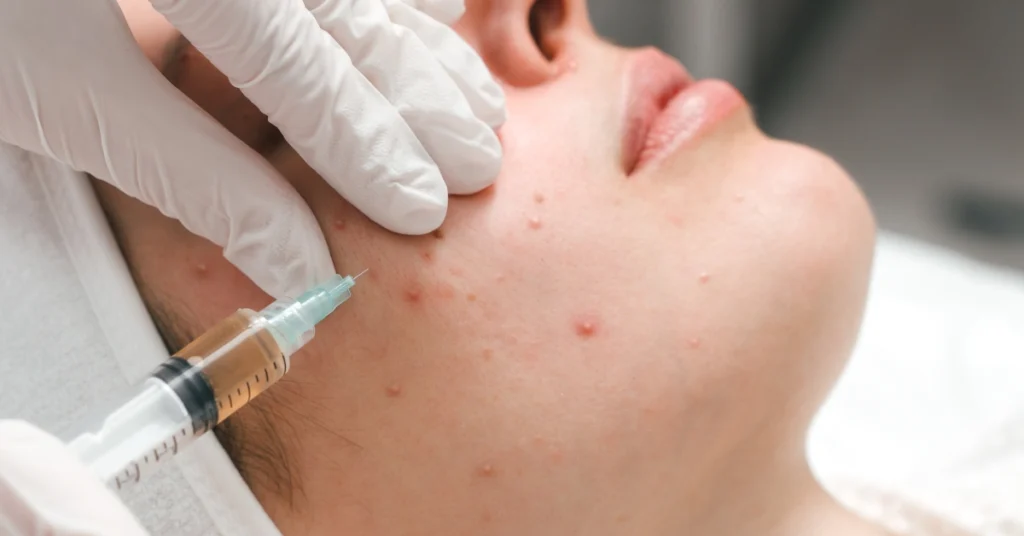Heartbreaks are not only when you have a breakup but also when your skin breaks into acne and scars. This poignant stance is more applicable for women than men. The visible scars dwindle the self-esteem affecting the overall quality of life. Statistically speaking, on assessing all the patients for the prevalence of depression as per BDI (Becks Depression Inventory) then nearly 38.27% patients had clinical depression. Another study found that 34% of patients with acne vulgaris had depressive disorder. However, various methods, including professional treatments and home remedies, can be employed to effectively treat acne scars and improve skin texture.
To prevent the formation of acne scars, it is crucial to treat acne promptly and prevent its progression. Early intervention can help in reducing the severity of breakouts and minimizing potential scarring.
Types of Acne Scars:
There are four primary types of acne scars:
- Ice Pick Scars – Deep, narrow, and pitted scars that resemble puncture marks.
- Box Scars – Broad, depressed scars with well-defined edges.
- Rolling Scars – Wave-like depressions caused by fibrous bands beneath the skin.
- Hypertrophic Scars – Raised scars that form due to excess collagen production.
Each type of scar requires a tailored treatment approach to achieve the best possible outcome.
Treatment Options for Acne Scars:
Several treatments are available to address different types of acne scars, including:
- Dermabrasion – A procedure that exfoliates the skin’s surface to improve texture and appearance.
- Laser Resurfacing – Utilizes laser technology to remove damaged skin layers and stimulate collagen production.
- Chemical Peels – Application of a chemical solution to exfoliate the skin and promote new skin growth.
- Subcision – A minimally invasive procedure where fibrous bands beneath scar tissue are cut using a specialized needle to release the skin.
Also Read: 5 Interesting Facts About Women Expressing Their Sexual Interest
Following subcision, fillers or platelet-rich fluid (PRF) may be injected beneath the skin to prevent the reformation of deep scars. Platelet-derived growth factors, such as transforming growth factor β and insulin-like growth factor, play a crucial role in tissue remodeling, repair, and endothelial cell proliferation, aiding in the healing process.
Due to the complex nature of acne scars, which often feature multiple scar types and active inflammatory lesions, a combination of procedures may be necessary to achieve optimal results. A personalized treatment plan is essential for effective scar management.
Preventing acne scars starts with proper skincare and acne management. Here are some key take-home messages to avoid scarring:
- Avoid picking or squeezing pimples to prevent further inflammation and scarring.
- Use lukewarm water to wash your face to avoid irritation.
- Incorporate a salicylic acid face wash to keep pores clear.
- Apply light, non-comedogenic moisturizers to keep the skin hydrated without clogging pores.
- Limit excessive sun exposure, which can increase oil production and cause pigmentation.
- Apply a broad-spectrum sunscreen to protect the skin from harmful UV rays.
- Avoid oil-based products that can exacerbate acne.
- Remove makeup thoroughly before bedtime to prevent clogged pores.
At Rejuvea Aesthetic Clinic, we conduct a thorough assessment to determine the types of acne scars present and tailor treatment plans accordingly. Our goal is to provide comprehensive care to help patients achieve smooth, healthy skin.
For appointments and inquiries: +91 6289053421
Visit us: First Floor Amar Kunj, 53 Sarat Bose Rd, Lansdowne Ln, Paddapukur, Bhowanipore, Kolkata, West Bengal 700025
Learn more: www.rejuveaaesthetic.in



